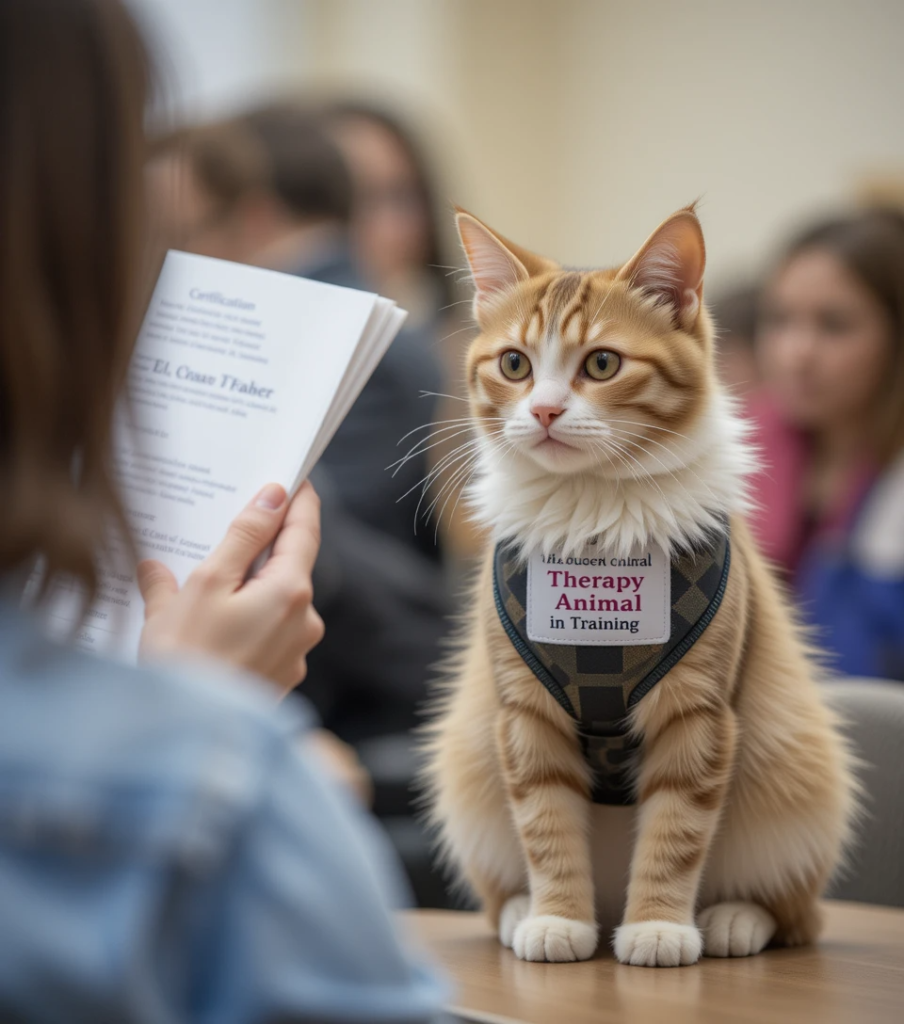Introduction: The Healing Power of Pets
The comforting purr of a cat, the gentle way they curl up beside you—it’s more than just cute behavior. For many people, cats offer a calming, healing presence that can profoundly impact mental and emotional well-being. While dogs often dominate the world of therapy animals, cats are quietly proving they have a unique kind of magic that brings comfort, emotional stability, and peace to those in need. But do cats truly make good therapy animals? Let’s explore the surprising answer.
What Is a Therapy Animal?

A therapy animal is specially trained to provide emotional comfort and support in various environments—hospitals, nursing homes, schools, and therapy clinics. Unlike service animals, which perform specific tasks for individuals with disabilities, or emotional support animals (ESAs), which offer companionship at home, therapy animals interact with multiple people, often in structured sessions.
Cats may not perform complex tasks, but their soothing presence, quiet behavior, and innate sensitivity to human emotions make them ideal therapy partners in certain settings.
Why Cats? Unique Qualities That Make Them Great Therapy Animals
Cats may not be the first animals that come to mind when you think of therapy, but they possess several qualities that make them surprisingly effective:
- Calm and Gentle Nature: Many cats have a relaxed demeanor that helps soothe people suffering from anxiety or trauma.
- Low Maintenance: They don’t need walks or constant attention, making them ideal for quieter, low-energy environments like nursing homes.
- Affectionate but Independent: Therapy cats offer affection without overwhelming people who may be emotionally sensitive.
- Size and Portability: Their smaller size allows them to comfortably sit on laps or bedsides without causing discomfort.
Scientific and Psychological Benefits of Cats in Therapy
Science backs the healing power of feline companionship. Interacting with cats has been shown to:
- Lower blood pressure
- Reduce cortisol levels (stress hormone)
- Increase serotonin and dopamine, which improve mood
- Encourage mindfulness through soft, repetitive actions like petting
- Alleviate loneliness and depression, especially in elderly or isolated individuals
These benefits are especially helpful in mental health therapy, trauma recovery, and autism support programs.
Real-Life Settings Where Therapy Cats Shine
Therapy cats have proven their worth in a variety of settings, including:
- Hospitals: Offering emotional support to patients during recovery
- Nursing Homes: Providing comfort to seniors dealing with isolation or dementia
- Schools and Libraries: Helping children improve focus and reduce anxiety
- Autism Centers: Supporting sensory regulation and social interaction
- Trauma Recovery Clinics: Easing emotional distress for individuals with PTSD
In these environments, therapy cats create a sense of calm, safety, and emotional connection.
Do All Cats Qualify? Traits of a Good Therapy Cat
Not every cat is cut out for therapy work. The best therapy cats share these traits:
- Friendly and sociable with strangers
- Calm under pressure and in unfamiliar environments
- Gentle and tolerant of touch and noise
- Healthy and well-groomed, with regular vet visits
Certain breeds like Ragdolls, Maine Coons, and British Shorthairs are often recommended due to their calm and affectionate temperaments.
Training and Certification for Therapy Cats

While cats don’t undergo rigorous training like service animals, they can be evaluated and certified for therapy work through programs like:
- Pet Partners
- Love on a Leash
- Therapy Cats International
These organizations assess a cat’s temperament, health, and behavior in public spaces before granting certification. Handlers are also trained to manage interactions safely and respectfully.
Cats vs. Dogs in Therapy Work
While both cats and dogs make excellent therapy animals, they each serve unique roles:
| Cats | Dogs |
|---|---|
| Quiet and calming presence | Energetic and playful engagement |
| Better suited for quiet spaces | More adaptable to high-energy environments |
| Less demanding of attention | Highly interactive with people |
| Lower maintenance overall | Requires more care and activity |
Cats may not replace dogs in all therapy settings, but they are a perfect fit for certain individuals and environments.
Challenges and Considerations
Before introducing a therapy cat into any setting, consider:
- Allergies: Some people may be allergic to cat fur or dander.
- Fear or dislike of cats: Not everyone is comfortable around felines.
- Environmental needs: Therapy cats require quiet, controlled spaces.
- Animal welfare: Cats must enjoy the experience to thrive in this role.
Choosing the right cat and setting ensures a positive experience for everyone involved.
Conclusion: Discovering the Magic of Feline Therapy
So, do cats make good therapy animals? The answer is a heartfelt yes. With their quiet strength, emotional intuition, and deeply comforting presence, cats bring a special kind of magic to therapeutic environments. While they may not be suited for every person or place, their growing role in pet-assisted therapy proves that healing can come with a soft purr and a gentle nudge.
❓ Frequently Asked Questions (FAQs)
- What makes a cat a good therapy animal?
A good therapy cat is calm, friendly, sociable, and comfortable in new environments and around strangers. - Can any cat become a therapy cat?
Not all cats are suitable; ideal candidates are gentle, confident, and well-socialized. - How do therapy cats help with anxiety or depression?
Their calming presence helps reduce stress hormones, improve mood, and provide emotional stability. - Are therapy cats recognized like service dogs?
No, therapy cats don’t have the same legal protections as service animals and typically require permissions for public access. - What breeds make the best therapy cats?
Ragdolls, Maine Coons, and British Shorthairs are commonly praised for their calm and affectionate nature. - How can I get my cat certified as a therapy animal?
You can apply through organizations like Pet Partners or Love on a Leash after your cat passes a temperament evaluation. - Where are therapy cats most commonly used?
They are often seen in hospitals, nursing homes, schools, and counseling centers. - Are there legal protections for therapy cats?
No, unlike service animals, therapy cats are not covered under the ADA and must follow facility guidelines. - What’s the difference between therapy cats and emotional support animals?
Therapy cats work with multiple people in structured environments; ESAs provide comfort to their owners at home. - Can children benefit from therapy cats?
Yes, especially children with anxiety, autism, or trauma can benefit greatly from feline companionship.

